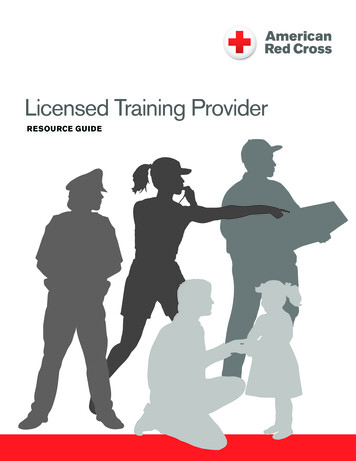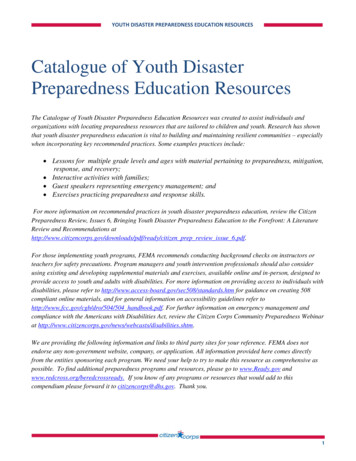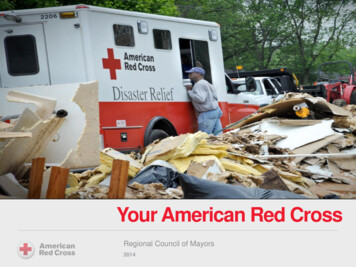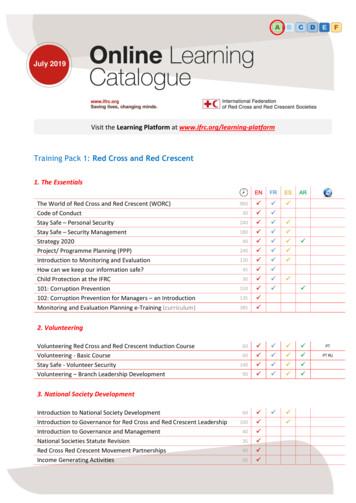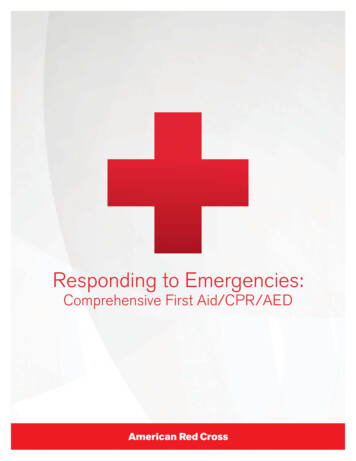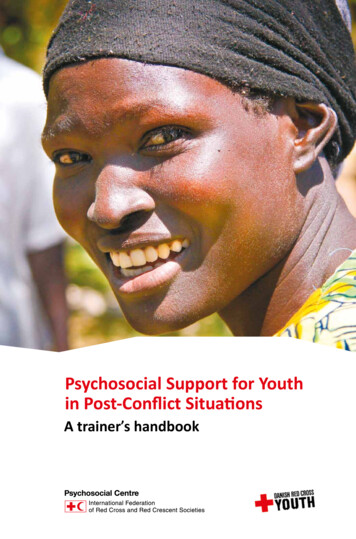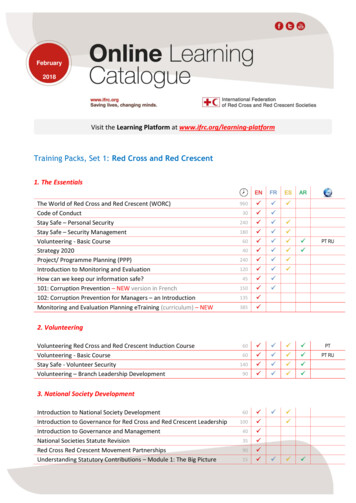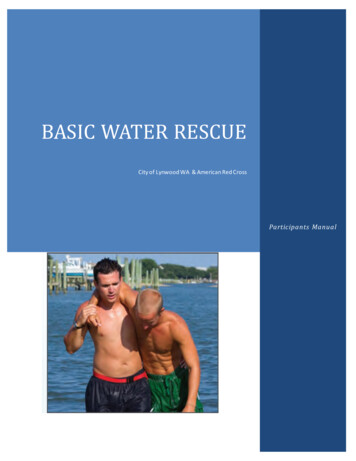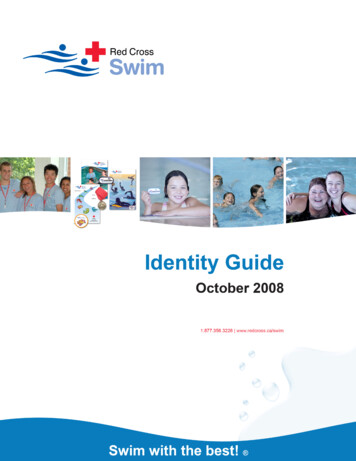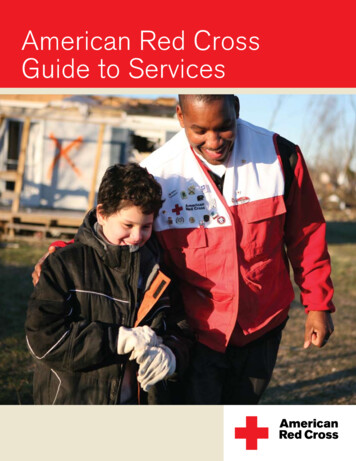
Transcription
American Red CrossGuide to Services
Mission of the American Red CrossThe American Red Cross, a humanitarian organization led by volunteersand guided by its Congressional Charter and the FundamentalPrinciples of the International Red Cross and Red Crescent Movement,will provide relief to victims of disasters and help people prevent,prepare for and respond to emergencies.
American Red Cross Guide to ServicesEach and every day, the more than 600 chapters and 36 BloodServices regions of the American Red Cross provide assistance andresources to communities across the United States. This AmericanRed Cross Guide to Services will help you learn more about our fivemajor lines of service.Whether it is a hurricane or a heart attack; a call for blood or a call forhelp, the American Red Cross is there.
American Red Cross Congressional CharterThe American Red Cross is chartered by Congress.Under the Congressional Charter, the organization’smission is defined, as is its governance structure (36U.S.C. §300101, et. Seq.). The charter also codifiesthat the American Red Cross and its chapters are asingle national corporation organized to help fulfillUnited States treaty obligations under the GenevaConventions. The charter mandates that the RedCross maintain a system of domestic and internationaldisaster relief, and entrusts the organization to serve asa medium of communication between members of themilitary and their families.The American Red Crossis a network of —In May 2007, the American National Red CrossGovernance Modernization Act (P.L. 110-26) wasenacted into law. This legislation amended the RedCross Congressional Charter for the first time in 60years. While the American Red Cross works closelywith governments at all levels, it is an independent,tax-exempt 501(c)(3) organization.nMore than 600 locally supported chapters.n36 Blood Services regions.n7 Blood Services divisions.n58 Service to the Armed Forces stations.nNearly 20 International Offices.In one of its first disaster relief operations, the American Red Cross set up feedingstations and provided medical care after the Johnstown, Pa., flood in 1889.American Red Cross Photo Archives2
American Red CrossFor more than 125 years, the mission of the AmericanRed Cross has been to help individuals and familiesprevent, prepare for and respond to emergencies. TheRed Cross provides disaster relief assistance to thoseaffected by natural and human-caused disasters.Through our Red Cross chapter network, we are ableto participate in federal, state and local governmentagency disaster planning exercises and responseefforts. We work closely with FEMA as co-leaders ofthe mass care portion of Emergency Support Function#6 of the National Response Framework. The RedCross also partners with community organizations andcorporate supporters to provide emergency shelter,food and health and mental health services as well asresources and referrals to aid in recovery.Every day through the American Red Cross, peoplemobilize to help their neighbors. More than half amillion volunteers and 30,000 employees of theRed Cross, many from communities like yours, helpprovide these life-changing and often lifesavingservices.Connecting the Armed ForcesWith Their FamiliesLong separations caused by military service createspecial needs for military families. The Red Crossprovides support to active-duty military members,National Guard and Reserve members, veteransand their families. We also provide emergencycommunication services, support for the sick andwounded at military and veterans hospitals andassistance in obtaining emergency financial support.The Red Cross is not a government agency; it relieson generous donations of time, money and blood todo its work. An average of 91 cents of every dollar theRed Cross spends is invested in humanitarian servicesand programs.Governed by volunteers and supported by voluntarydonations, the American Red Cross is a network of —nMore than 600 locally supported chapters.n36 Blood Services regions.n7 Blood Services divisions.n58 Service to the Armed Forces stations.nNearly 20 International Offices.Teaching Lifesaving SkillsAmerican Red Cross training and educationalprograms help to save lives and empower peopleto respond to disasters and other life-threateningemergencies. The American Red Cross helpsensure that individuals, families and organizationsare prepared for disasters and other life-threateningemergencies through developing and implementinglifesaving training and education programs andmaterials. More than 15 million people each yeargain lifesaving skills and preparedness information—including first aid, CPR and the use of defibrillators—through their local Red Cross chapter. As a result, ourcommunities are safer because of Red Cross training.The Red Cross provides a unique, communitybased network focused on the following five majorareas of service.Helping Disaster VictimsPeople affected by disaster need to know that theyhave a place to stay, food to eat and emotionalsupport as they take the first steps to recovery.Each year, the American Red Cross responds tomore than 70,000 disasters nationwide. While thevast majority of these disasters are single-familyand apartment home fires, the American Red Crossstands ready to support all affected in their immediateemergency needs. In addition to those individualsaffected by a disaster, the American Red Crossprovides immediate support to first responders.Collecting, Testing and Supplying BloodAcross Our NationFor more than 50 years, the American Red Cross hasbeen committed to ensuring the availability of thesafest possible blood and blood products to help meetAmerica’s blood needs. Every two seconds, someonein the United States needs a blood transfusion.Thanks to the generosity of its almost 4 million blooddonors, the American Red Cross is the largest singleblood supplier in the United States.3
Talia Frenkel/American Red CrossA girl in Haiti receives clean drinking water from the Red Cross after the earthquake in January 2010.Partnering in International ServicesThe American Red Cross is one of more than 180Red Cross and Red Crescent societies worldwidethat are devoted to alleviating human sufferingwherever it is found. The members of the globalRed Cross and Red Crescent network—includingthe International Committee of the Red Cross (ICRC),the International Federation of Red Cross and RedCrescent Societies (International Federation) and theRed Cross and Red Crescent national societies—work together toward common goals during timesof crisis or disaster.As a national society, the American Red Cross workswithin this framework to help provide services forthe world’s most vulnerable people. The AmericanRed Cross works with our partner Red Cross andRed Crescent societies in more than 30 countriesto support projects in disaster management andemergency health. In the United States, localRed Cross chapters support efforts to reconnectfamilies separated by international disasters, aswell as educate the public about internationalhumanitarian law.4
Disaster ServicesEach year, the American Red Cross respondsimmediately to nearly 70,000 disasters, includingsingle-family and apartment home fires (themajority of disaster responses), hurricanes, floods,earthquakes, wildfires, tornadoes, hazardous materialsspills, transportation accidents, explosions and othernatural and human-caused disasters.distribution of needed items to meet the basic humanneeds of those affected. Red Cross workers alsomeet one-on-one with clients to provide informationand assistance and to connect them to otherresources that can help to support their recovery.During times of disaster, the Red Cross providesblood and blood products to disaster victims andhelps those affected by disaster to access otheravailable resources.Although the American Red Cross is not agovernment agency, its authority to provide disasterrelief was formalized when, in 1905, the Red Crosswas chartered by the U.S. Congress to “carry on asystem of national and international relief in timeof peace and apply the same in mitigating thesufferings caused by pestilence, famine, fire, floodsand other great national calamities, and to deviseand carry on measures for preventing the same.” Thecharter is not only an assignment of responsibility, butalso an obligation to the nation, to disaster victims andto the people who generously support its work withtheir donations.The American Red Cross is also able to facilitatefamily communication through its Safe and Wellwebsite, found on redcross.org. The Safe and Wellwebsite allows individuals to register their well-beingusing messages that can be seen by family and friendsinquiring about their loved one’s safety. When inquiriesinvolve individuals with serious pre-existing healthand mental health conditions inside a disaster area,Welfare Information Teams search for the vulnerableindividuals, get them the help they need and help themreconnect with their worried loved ones.Red Cross disaster relief focuses on meeting people’surgent disaster-caused needs. When a disasterthreatens or strikes, the Red Cross provides shelter,food, health and mental health services, and bulkEmphasizing Disaster ReadinessDisasters deprive families of homes and belongings,cause major disruptions to businesses and costbillions of dollars. This immense social and economicimpact can be dramatically reduced if families,businesses and communities take proactive stepsto reduce their vulnerabilities. Therefore, disasterreadiness and mitigation are priorities of the AmericanRed Cross.Awareness and EducationWe develop and distribute a variety of materials invarious languages to educate the public. This includeselectronic capabilities, printed and video materials aswell as public service announcements (PSAs) andcommunity presentations that inform the public abouthow to stay safe and protect their homes.Direct Mitigation and AdvocacyWe have partnered with the U.S. Department ofHomeland Security, Federal Emergency ManagementAgency (FEMA), the insurance industry, emergencymanagement and environment officials, educators,businesses and others who are concerned about theincreasing, and often unnecessary, losses caused bydisasters. Across the nation, we are working to builda “culture of preparedness” and to limit the harminflicted on families and communities by disasters.Gene Dailey/American Red CrossRed Cross president and CEO Gail McGovern serves hot mealsfrom the back of a Red Cross mobile response vehicle to familiesaffected by Hurricane Ike.5
Service to the Armed ForcesPrior to deployment, Red Cross workers educateservice members and their families regarding availableRed Cross support services, including assistancethey can seek during deployment. Both active-dutyand community-based military rely on the Red Crossto provide access to vital services such as financialassistance, counseling, family support groups,information and referrals to medical professionals. TheRed Cross recently introduced a course especially formilitary families entitled, “Coping With Deployments:Psychological First Aid for Military Families.” Thecourse teaches resiliency strategies for families andincludes a special module for children.The Service to the Armed Forces (SAF) programensures that service members, veterans and theirfamilies have worldwide, around-the-clock accessto timely and reliable humanitarian services. Whileproviding assistance to 1.4 million active-dutypersonnel and their families, the Red Cross alsoreaches out to more than 1.2 million members ofthe National Guard/Reserves and their familieswho reside in nearly every community in America.SAF services are delivered through the Red Crosschapter network in the United States and on militaryinstallations around the world.The American Red Cross keeps pace with a changingmilitary. The Red Cross sends communications onbehalf of family members who are facing emergenciesor other important events to members of the U.S.Armed Forces serving all over the world. Messagesare delivered around-the-clock, 7 days a week, 365days a year.The Red Cross additionally supports veterans andtheir families by representing them before the Boardof Veterans Appeals. Red Cross volunteers arecertified by the U.S. Department of Veterans Affairsto work in nearly every medical facility. They providea wide range of support to veterans via communitybased programs in addition to the traditional supportveterans receive in VA medical centers.Emergency communications services havebeen provided to members of the military andtheir families for more than 100 years as part ofthe 1905 Congressional Charter that requiresthe American Red Cross to act “in accordwith military authorities as a medium ofcommunications between the people ofthe United States and their armed forces.”The Red Cross works hand-in-hand with militaryhospitals and wounded warrior units, providingmaterial assistance that is vitally needed for thecomfort and recovery of service members. TheRed Cross is assisting not only the service memberscurrently in warrior transition units, but also those inveterans health care facilities, family members, andsurviving spouses, as well. Our services improve themorale, welfare and general quality of life of hospitalpatients and provide family members with peaceof mind. SAF staff also offer respite from harshconditions and bring a little bit of home to the troopsoverseas by operating 24-hour canteen services withcoffee, cold drinks, snacks, games, videos, books andInternet access.Daniel Cima/American Red CrossAn American Red Cross worker talks with a service member atLandstuhl Regional Medical Center in Germany.6
Health and Safety ServicesAmerican Red Cross Health and Safety Serviceshelps to save lives and strengthen communities—imparting hope and confidence along with practicalskills. It is the premier provider of education, trainingand products that enable people to prevent, preparefor and respond to disasters and other life-threateningemergencies through programs and services thatinclude:nFirst Aid/Cardiopulmonary Resuscitation (CPR)/Automated External Defibrillation (AED)nAquatics, such as basic swim lessons, Lifeguardingand Water SafetynCaregiving, including Babysitter’s Traininga simple message and a call to action. In today’sclimate, it is more important than ever that all of usbe prepared for possible emergencies, and there arethree actions everyone can take that can help makea difference.1. Get a Kit. What you have on hand when adisaster happens can make a big difference. Haveat least three days of supplies for everyone inyour household, including your pets. Include anynecessary items for infants, seniors and peoplewith disabilities in your kit. Keep a smaller versionof the kit in your vehicle. Information on what toinclude in a kit is available on redcross.org.2. Make a Plan. Planning ahead is the first stepto a calmer and more assured disaster response.Design a family communication plan that includesan evacuation plan and coordinates with schools,work and communities’ communication plans.PreparednessJust as every disaster is an intensely personalexperience, the American Red Cross believes that acommitment to making our homes and communitiessafe is also personal. Therefore, the American RedCross works closely with local, state and nationalpartners to help people personalize their risk tonatural hazards and make preparedness a personalpriority. The goal is to build a “culture of preparedness”that helps communities become safer and moreprepared when disasters strike. The American RedCross has numerous preparedness materials availablein multiple languages.3. Be Informed. When a major disaster occurs, yourcommunity can change in an instant. Knowingwhat may happen and how you can help maymake all the difference when an emergencyhappens. Make sure that at least one memberof your household is trained in first aid, CPR andAED use.To learn more about the Be Red Cross Ready initiative,go to an online presentation at redcross.org. Themodules, which are available in English and Spanish,contain pictures, audio and video content that helpindividuals and their families become safer, healthierand more resilient in the face of an emergency.Be Red Cross ReadyBe Red Cross Ready represents the cooperativeefforts of the American Red Cross and theDepartment of Homeland Security’s Ready Campaignto encourage the public to be more prepared for adisaster or other emergency. This program containsThe American Red Cross trainsmillions of people in CPR/AEDand first aid each year.Daniel Cima/American Red Cross7
Blood ServicesQuality Assurance UnitOur Quality Assurance unit reviews the processesdeveloped and used in American Red Cross facilitiesto manufacture FDA-regulated products. The unitdetermines if the facilities meet appropriate regulatoryand compliance standards. Quality Assurance utilizesthe FDA’s Good Manufacturing Practice regulations.American Red Cross Blood Services touchesmany lives every day. The use of current medicaltechnologies allows us to be a leader in transfusionmedicine and to provide a variety of blood productsfor the hospitals and transfusion centers we serve.The American Red Cross and its Board of Governorshave made a strong commitment to the U.S. Food andDrug Administration (FDA) to ensure that regulatorycompliance continues to be a top priority.The Quality Assurance unit examines donor eligibilityscreening practices; support systems, such asRed Cross testing laboratories and informationtechnology; and functions at Biomedical Servicesheadquarters. The unit trains auditors, preparesaudit reports and related analyses for Red Crossmanagement and participates in various committeesat Biomedical Services headquarters. Many of theunit’s activities are governed by the 2003 AmendedConsent Decree with the FDA as well as the biologicsand pharmaceutical sections of the Code of FederalRegulations.Safety FirstMedical advances in blood donor screening andtesting have dramatically improved blood safety.Changes in technology have also imposed enormousdemands on blood centers. The National TestingLaboratories of the American Red Cross efficientlyprocess and test donor samples and provide reliableresults in a timely manner.You can save lives by donating blood. Pleasecall 1-800-RED CROSS or visit us online atredcrossblood.org to schedule your blood donationappointment. If you are ineligible to give, pleaseconsider encouraging others to donate. If you havenever donated blood, schedule an appointment todonate, and you’ll see how good it feels to help save alife. Your donation can help save more than one life,including accident victims, cancer patients andchildren with blood disorders.Blood is tested at Red Cross nationaltesting labs across the country.Daniel Cima/American Red Cross8
Consent DecreeIn April 2003, the Red Cross and the FDA reachedagreement on terms of an Amended Consent Decree,which provides legal guidance on the handling ofdonated blood. Both organizations are committedto further enhancing the safety of America’s bloodsupply under the Amended Consent Decree.nThe nation’s blood supply is safer today than it hasever been.nThe Red Cross is committed to keeping the bloodsupply as safe as possible and to holding itselfaccountable to the highest standards set byregulators and the American public it serves.nThe FDA wanted increased authority to ensurecompliance, and viewed financial penalties as animportant component. The Red Cross agreed thatthe FDA had the right to fine the organizationif it is found to be in non-compliance withrequirements in the future.nThe Red Cross recognizes that these challengescannot be solved overnight; however, there isno higher priority than, or acceptable excuse for,anything but full compliance.Fast Facts nEvery day, the Red Cross relies on volunteerdonors to give enough blood to help treat peoplewith illnesses and injuries.nThe American Red Cross needs to collect22,000 units of blood each weekday to meetpatient needs. In addition, we must collect about15,000 units each weekend.nEach year, the Red Cross collects approximately6.5 million units of blood, from roughly 4 millionvolunteer blood donors.nFrom these donations, the Red Cross distributesaround 9.5 million blood products each year,including 6 million red cells, to patients atapproximately 3,000 hospitals and transfusioncenters across the country.nThis work is accomplished through theorganization’s national network, composed of7 divisions and 36 blood regions.nThe Red Cross is the nation’s largest singlesupplier of blood and blood products.Roughly 4 million volunteerblood donors give the gift of life atRed Cross blood drives each year.Andrew Yates/American Red Cross9
International ServicesEmergency HealthAmerican Red Cross international health initiativesfocus on tackling the challenges of measles and otherdiseases. The American Red Cross is a foundingmember of the Measles Initiative, a partnershipcommitted to reducing measles deaths globally by90 percent between 2000 and 2010. The Initiativehas supported the vaccination of more than 700million children worldwide, primarily in Africa andAsia. Largely due to the Measles Initiative, measlesdeaths declined by 78 percent globally between 2001and 2008. The American Red Cross also supportsinitiatives that help prevent HIV and provide care andsupport to people living with HIV/AIDS, as well ascommunity-based health and first aid education.The American Red Cross helps vulnerable peoplearound the world to prepare for, respond to andrecover from disasters, armed conflicts and lifethreatening health conditions.The American Red Cross accomplishes these goals byworking within the global Red Cross and Red Crescentnetwork. The Red Cross is the world’s largesthumanitarian network with more than 180 national RedCross and Red Crescent societies and approximately97 million volunteers, members and staff.The American Red Cross works to build the capacityof our partner national societies by strengtheningtheir leadership, financial management, volunteernetworks and technical capabilities. With globalRed Cross partners, the American Red Crossworks to train and organize volunteers and educatecommunities to empower them with the skills theyneed to help themselves. To ensure that programsare comprehensive, the American Red Crossestablishes partnerships with other public and privateorganizations whose capabilities strengthen andcomplement our initiatives.Restoring Family LinksThrough the global Red Cross network, the AmericanRed Cross works to locate loved ones who aremissing due to war, natural disaster or civil unrest andsend Red Cross messages between these separatedfamily members.International Humanitarian Law (IHL)EducationThe American Red Cross educates the Americanpublic about IHL’s guiding principles of humanity,impartiality and neutrality established by the GenevaConventions and taught in courses by trainedinstructors. Our Exploring Humanitarian Law (EHL)program provides educators with the learningmaterials and strategies to help students, ages 13-18,to explore issues of humanitarian law and principlesof respect for life and human dignity.American Red Cross international programs focus ondisaster management, disease prevention, restoringfamily links and the promotion of internationalhumanitarian law. For each of these priority areas, wepromote cost-effective, community-based programsthat target large numbers of people with humanitarianaid that is rapid, effective and large scale.Disaster Response and PreparednessAmerican Red Cross response activities focus onrelief supply distribution, shelter, healthcare, waterand sanitation services and reconnecting families.We also implement disaster preparedness programsto create more resilient communities with decreaseddependence on external relief assistance. Followingthe devastating 2010 earthquake in Haiti, theAmerican Red Cross established the Haiti AssistanceProgram to assist survivors and their communities.The American Red Cross and its partners have helpedmore than 2 million people with programs focusedon providing homes, water and sanitation; preventingdisease and providing medical care; restartinglivelihoods and preparing for future disasters. Inaddition, our programs are providing emergencyassistance to refugees from conflicts.Kun Li/UNICEFMothers, such as this one in Zimbabwe, bring their childrento vaccination centers run by Red Cross and Red Crescentvolunteers.10
American Red Cross VolunteersThe American Red Cross has been able to provide services formore than 125 years in large part because of the tireless anddedicated work of volunteers. All across the United States, morethan half a million “Red Crossers” help save lives by providingassistance to disaster victims, delivering community educationcourses and working with millions of volunteer blood donors.This special family includes individuals who help with a single eventor who volunteer several times a month. Many Red Crossers havebeen involved in their communities for 10, 20 or even 80 years,providing lifesaving services and leadership and helping to prevent,prepare for and respond to emergencies. Our volunteers representtheir communities, speak many different languages, are of alldifferent ages and represent all races and ethnicities. We invite youto join us. Help make the Red Cross even stronger and better.A Helping HandAmong other things, Red Cross volunteers—nnnnnAssist victims of hurricanes, earthquakes, tornadoes, floods,winter storms, wildfires and home fires.Help wounded service members with their recovery.Provide community disaster education in first aid, CPR/AED,swimming, babysitter training and other classes.Donate blood to meet the needs of accident victims,cancer patients and others.Help vulnerable people around the world prepare for,respond to and recover from disasters.11
The Red Cross began in 1859, whenHenry Dunant, a young Swiss man,came upon the scene of a bloodybattle in Solferino, Italy, between thearmies of imperial Austria and theFranco-Sardinian alliance. Some40,000 men lay dead or dying onthe battlefield. The wounded lackedmedical attention. Dunant organizedlocal people to bind the soldiers'wounds and to feed and comfortthem. On his return, he called forHenry Dunantthe creation of national relief societiesto assist those wounded in war, andpointed the way to the future Geneva Conventions.American Red Cross Photo ArchivesThe International Movement in BriefIn October 1863, the International Red Cross Movement was createdin Geneva, Switzerland, to provide nonpartisan care to the woundedand sick in times of war. The Red Cross emblem was adopted at thisfirst International Conference as a symbol of neutrality and was to beused by national relief societies. In August 1864, the representativesof 12 governments signed the Geneva Convention Treaty.Today, the global Red Cross and Red Crescent network is composedof the Geneva-based International Committee of the Red Cross(ICRC) and the International Federation of Red Cross and RedCrescent Societies (International Federation), as well as nationalsocieties in more than 180 countries, including the American RedCross.12
Fundamental Principles of theInternational Red Cross and Red Crescent MovementAs part of the International Red Cross and Red Crescent Movement,the American Red Cross follows these seven fundamental principles.HumanityThe International Red Cross and Red Crescent Movement (the Movement), born ofa desire to bring assistance without discrimination to the wounded on the battlefield,endeavors, in its international and national capacity, to prevent and alleviate humansuffering wherever it may be found. Its purpose is to protect life and health and toensure respect for the human being. It promotes mutual understanding, friendship,cooperation and lasting peace amongst all people.ImpartialityIt makes no discrimination as to nationality, race, religious beliefs, class or politicalopinions. It endeavors to relieve the suffering of individuals, being guided solely bytheir needs, and to give priority to the most urgent cases of distress.NeutralityIn order to continue to enjoy the confidence of all, the Movement may not take sidesin hostilities or engage at any time in controversies of a political, racial,religious or ideological nature.IndependenceThe Movement is independent. The national societies, while auxiliaries in thehumanitarian services of their governments and subject to the laws of theirrespective countries, must always maintain their autonomy so that they may be ableat all times to act in accordance with the principles of the Movement.Voluntary ServiceIt is a voluntary relief movement not prompted in any manner by desire for gain.UnityThere can be only one Red Cross or Red Crescent society in any one country. Itmust be open to all. It must carry on its humanitarian work throughout its territory.UniversalityThe International Red Cross and Red Crescent Movement, in which all societieshave equal status and share equal responsibilities and duties inhelping each other, is worldwide.
For more information about the American Red Cross,contact your local chapter or visit redcross.org. 2011 The American National Red Cross. The American Red Cross nameand logo are registered trademarks of the American Red Cross.A1743-01/11
While the American Red Cross works closely with governments at all levels, it is an independent, tax-exempt 501(c)(3) organization. In one of its first disaster relief operations, the American Red Cross set up feeding stations and provided medical care after the Johnstown, Pa., flood in 1889. American Red Cross Photo Archives The American Red CrossFile Size: 650KB
